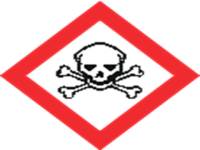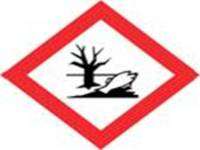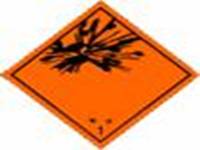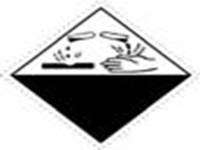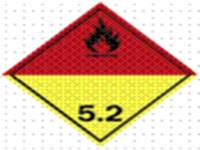HazMat Course Module 6
UN GHS SYSTEM CLASSIFICATION
and labeling of chemicals.
Chemicals, through the different steps from their production to their handling, transport and use, are a real danger for human health and the environment. People of any ages, from children to the elderly, using many different languages and alphabets, belonging to various social conditions, including illiterates, are daily confronted to dangerous products (chemicals, pesticides, etc).
To face this danger, and given the reality of the extensive global trade in chemicals and the need to develop national programs to ensure their safe use, transport and disposal, it was recognized that an internationally-harmonized approach to classification and labelling would provide the foundation for such programs. Once countries have consistent and appropriate information on the chemicals they import or produce in their own countries, the infrastructure to control chemical exposures and protect people and the environment can be established in a comprehensive manner.
The GHS is an acronym for The Globally Harmonized System of Classification and Labelling of Chemicals. The GHS is a system for standardizing and harmonizing the classification and labelling of chemicals. It is a logical and comprehensive approach to:
- Defining health, physical and environmental hazards of chemicals;
- Creating classification processes that use available data on chemicals for comparison with the defined hazard criteria; and
- Communicating hazard information, as well as protective measures, on labels and Safety Data Sheets (SDS).
The GHS also provides a basis for harmonization of rules and regulations on chemicals at national, regional and worldwide level, an important factor also for trade facilitation.
The GHS provides countries with the regulatory building blocks to develop or modify existing national programs that address classification of hazards and transmittal of information about those hazards and associated protective measures. This helps to ensure the safe use of chemicals as they move through the product life cycle from “cradle to grave.”
The GHS covers all hazardous chemical substances, dilute solutions and mixtures. Pharmaceuticals, food additives, cosmetics and pesticide residues in food are not covered by the GHS.
The GHS is therefore highly relevant to the work of the poison centre in that it classifies products which present a potential health risk; it provides a means of communicating this to consumers through the use of labels and safety data sheets and may advise them to contact a poison centre following exposure. Various elements of the GHS e.g. the safety data sheet may present opportunities for the poison centre to provide health information to companies marketing products. Provision of a safety data sheet to a poison centre may be the first time that the centre has encountered the product. Contact with the centre regarding an exposure may involve giving information from a product label which in turn requires the centre to have an understanding of the fundamentals of the GHS.
GHS Historical Background
The work about the elaboration of the GHS began with the premise that existing systems should be harmonized in order to develop a single, globally harmonized system to address classification of chemicals, labels, and safety data sheets. This was not a totally novel concept since harmonization of classification and labelling was already largely in place for physical hazards and acute toxicity in the transport sector, based on the work of the United Nations Economic and Social Council's Committee of Experts on the Transport of Dangerous Goods (UNCEDTG). Harmonization had not been achieved in the workplace or consumer sectors, however, and transport requirements in countries were often not harmonized with those of other sectors in that country.
Chapter 19 of Agenda 21, adopted at the UN Conference on Environment and Development (UNCED, 1992), provided the international mandate to complete this task. The work was coordinated and managed under the auspices of the Inter-Organization Programme for the Sound Management of Chemicals (IOMC) Coordinating Group for the Harmonization of Chemical Classification Systems (CG/HCCS). The technical focal points for completing the work were: the International Labour Organization (ILO) for the hazard communication; the Organization for Economic Cooperation and Development (OECD) for the classification of health and environmental hazards; and the UN Sub-committee of Experts on the Transport of Dangerous Goods (UNSCETDG) and the ILO for the physical hazards.
It required a long-term commitment from all of these organizations that they maintained over the years. By resolution 1999/65 of 26 October 1999 the United Nations Economic and Social Council decided to enlarge the mandate of the Committee of Experts on the Transport of Dangerous Goods by reconfiguring it into a Committee of Experts on the Transport of Dangerous Goods and on the Globally Harmonized System of Classification and Labelling of Chemicals (CETDGGHS), and by creating, besides the Sub-Committee of Experts on the Transport of Dangerous Goods (TDG Sub-Committee), a new Sub-Committee of Experts on the Globally Harmonized System of Classification and Labelling of Chemicals (GHS Sub-Committee).
In its Plan of Implementation (para 22.©) adopted in Johannesburg on 4 September 2002, the World Summit on Sustainable Development (WSSD) encouraged countries to implement the new GHS as soon as possible with a view to having the system fully operational by 2008.
GHS Classification
Classification is the starting point for hazard communication. It involves the identification of the hazard(s) of a chemical or mixture by assigning a category of hazard/danger using defined criteria. The GHS includes classification criteria and standardized hazard communication elements for physical hazards, health hazards, and one environmental hazard.
Annexe 2 of the UN GHS system contains classification and labelling tables.
Physical Hazard Classes:
- Explosives
- Flammability – gases, aerosols, liquids, solids
- Oxidizers – liquid, solid, gases
- Self-Reactive
- Pyrophoric – liquids, solids
- Self-Heating
- Organic Peroxides
- Corrosive to Metals
- Gases Under Pressure
- Water activated flammable gases
Health and Environmental Hazard Classes:
- Acute Toxicity
- Skin Corrosion/Irritation
- Serious Eye Damage/Eye Irritation
- Respiratory or Skin Sensitization
- Germ Cell Mutagenicity
- Carcinogenicity
- Reproductive Toxicity
- Target Organ Systemic Toxicity – Single and Repeated Dose
- Hazardous to the Aquatic Environment
Each class is assigned a category of hazard. For example, for acute toxicity, substances are assigned to one of the five toxicity categories on the basis of LD50 (oral, dermal) or LC50 (inhalation).
For example, after considering the physical, health and environmental hazard data for Ethanol, the GHS classification is:
- Acute Toxicity (oral): Category 5
- Eye Irritation: Category 2A
- Flammable Liquid: Category 2
- Respiratory Irritation: Category 3
- Skin Corrosion/ Irritation: Category 3
The New Zealand Risk Management Authority has adopted a GHS classification framework which is substantially equivalent to the UN GHS. The Biological and Physical classification systems are given below which may be helpful in explaining the classification concept.
The New Zealand Risk Management Authority has classified a large list of chemicals as part of the Hazardous Substances and New Organisms (HSNO) Act and Regulatory framework. This is the HSNO Chemical Classification Information Database, a useful resource for providing further examples of GHS classified chemicals.
GHS Hazard Communication
Once a chemical has been classified, the hazard(s) must be communicated to target audiences. As in existing systems, labels and Safety Data Sheets are the main tools for chemical hazard communication. They identify the hazardous properties of chemicals that may pose a health, physical or environmental hazard during normal handling or use. The goal of the GHS is to identify the intrinsic hazards found in chemical substances and mixtures, and to convey information about these hazards.
The international mandate for the GHS included the development of a harmonized hazard communication system, including labelling, Safety Data Sheets and easily understandable symbols, based on the classification criteria developed for the GHS.
The standardized label elements include symbols/pictograms, use of two signal words (danger and warning), and hazard statements for each hazard class and category. To be consistent with the GHS, labels should also include product and supplier identifiers and precautionary statements, although these have not been standardized. In addition, it is consistent with the GHS to include supplemental information on the label, to give more detail or cover additional hazards, provided the supplemental information does not undermine the GHS label information. The system further specifies format and contents for hazard communication in Safety Data Sheets, used primarily in the workplace.
GHS Pictograms
Signal Words
The signal word indicates the relative degree of severity a hazard. The signal words used in the GHS are:
“Danger” for the more severe hazards, and
“Warning” for the less severe hazards.
Signal words are standardized and assigned to the hazard categories within endpoints. Some lower level hazard categories do not use signal words. Only one signal word corresponding to the class of the most severe hazard should be used on a label.
Hazard Statements
Hazard statements are standardized and assigned phrases that describe the hazard(s) as determined by hazard classification. An appropriate statement for each GHS hazard should be included on the label for products possessing more than one hazard. The assigned label elements are provided in each hazard chapter of the GHS. The figure below illustrates the assignment of standardized GHS label elements for the acute oral toxicity categories.
Precautionary statements
A precautionary statement means a phrase (and/or pictogram) that describes recommended measures that should be taken to minimise or prevent adverse effects resulting from exposure to a hazardous product, or improper storage or handling of a hazardous product. The GHS label should include appropriate precautionary information, the choice of which is with the labeller or the competent authority. Precautionary statements, therefore, are necessary to protect users from adverse effects resulting from exposure, improper storage or handling of a hazardous product. Precautionary statements cover the aspects of prevention, response in cases of accidental spillage or exposure, storage, and disposal, the choice of which is with the labeller or the competent authority.
The use of precautionary response statements such as “Immediately call a POISON CENTRE or doctor/physician” following a toxic exposure assumes that a poison centre will have the information on the product necessary to give an adequate response. It is therefore important for poison centres to have access to product information, particularly the nature of the ingredients and relevant health data.
First aid statements
First aid advice for initial care should only suit the needs of an untrained responder without sophisticated equipment. First aid should be provided until further medical advice or care can be obtained. Poison centres may be contacted by manufacturers of hazardous substances to give advice on appropriate first aid procedures.
The SDS first aid statements may not always be correct if it has been written by a company without resort to specialist help.
GHS Label Elements
Example. GHS label for Acetone
The (Material) Safety Data Sheet (SDS) provides comprehensive information for use in workplace chemical management. Employers and workers use the SDS as sources of information about hazards and to obtain advice on safety precautions. The SDS is product related and, usually, is not able to provide information that is specific for any given workplace where the product may be used. However, the SDS information enables the employer to develop an active program of worker protection measures, including training, which is specific to the individual workplace and to consider any measures that may be necessary to protect the environment. Information in a SDS also provides a source of information for other target audiences such as those involved with the transport of dangerous goods, emergency responders, poison centers, those involved with the professional use of pesticides and consumers.
The SDS contains 16 headings. The SDS should provide a clear description of the data used to identify the hazards.
For further reading visit: US Hazard Communication
ASSIGNMENT
1. What is the GHS?
2. What hazards of a chemical are used for the GHS classification criteria?
3. What GHS pictogram does this represent?
4. What is a precautionary statement?
5. What signal word is featured in the following GHS label.
2 – Methyl Flammaline
Keep away from heat, sparks and flame – No smoking
Keep Container closed. Use only in well ventilated areas.
Wash thoroughly after handling. Avoid contact.
ABC Chemical Co. 302 David Road, Dunedin 0800 – 450879
6. What sections of a Safety Data Sheet could Poison Centres readily contribute in assisting companies to wishing to compile an SDS.







